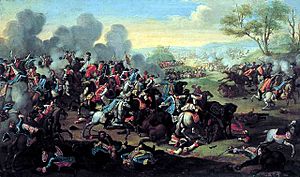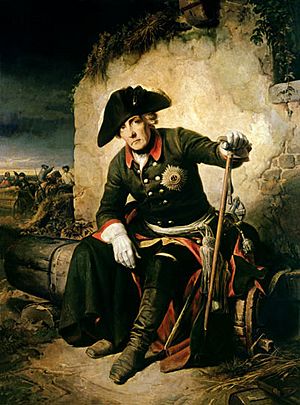Battle of Kolín facts for kids
Quick facts for kids Battle of Kolín |
|||||||
|---|---|---|---|---|---|---|---|
| Part of the Third Silesian War (Seven Years' War) | |||||||
 Schlacht bei Kolin, unknown artist |
|||||||
|
|||||||
| Belligerents | |||||||
| Commanders and leaders | |||||||
| Leopold von Daun | Frederick the Great | ||||||
| Strength | |||||||
| 53,790 154 guns |
34,000 90 guns |
||||||
| Casualties and losses | |||||||
| 8,000 | 14,000 | ||||||
The Battle of Kolín was a major fight during the Seven Years' War. It happened on June 18, 1757, near the city of Kolín in what is now the Czech Republic. In this battle, the Austrian army, led by Count von Daun, defeated the Prussian army, led by Frederick the Great. This was a big surprise because Frederick was known as a brilliant military leader. The battle forced Frederick to change his plans and retreat.
Contents
Why the Battle of Kolín Happened
The Seven Years' War was a huge conflict involving many European powers. One part of it was the Third Silesian War between Prussia and Austria. Prussia's King Frederick II had just won a tough battle near Prague on May 6, 1757. After that victory, he started to besiege the city, trying to capture it.
Meanwhile, Austrian Marshal Daun arrived too late for the Prague battle. But he gathered 16,000 Austrian soldiers who had escaped. With this new force, he slowly moved to help the city of Prague. Frederick knew he had to stop Daun. So, on June 13, he left some troops to continue the siege of Prague. He then marched with 34,000 of his own soldiers to meet Daun's army.
Marshal Daun's army was smaller than Frederick's combined forces (including those still at Prague). Daun knew Frederick couldn't keep besieging Prague and fight him at the same time. So, Daun chose a strong defensive spot on hills near Kolín. He waited for Frederick there on the night of June 17.
How the Battle of Kolín Was Fought
On June 18, 1757, Frederick's army attacked the Austrians. The Austrians were ready, holding strong positions on the hills. They had about 53,790 soldiers and 154 cannons. Frederick's plan was to attack the Austrian army from the side, specifically their right flank. He wanted to trick the Austrians by keeping only a few soldiers in the middle. Most of his army would then secretly move to the left. From there, they would turn right and hit the Austrian flank hard. This would give the Prussians a big advantage in that area.
However, Frederick's main force turned too early. Instead of attacking the Austrian side, they ended up attacking them head-on. Austrian light infantry, called Grenzers, played a key role. They bothered the Prussian soldiers, making them attack too soon.
The Austrians fired their muskets and cannons, stopping the Prussian attack. The Austrians even tried to counter-attack, but Prussian cavalry pushed them back. Frederick sent more troops into the fight. But this new attack was also stopped and then crushed by Austrian cavalry. By the afternoon, after about five hours, the Prussians were confused and being pushed back.
Just when things looked bad, Prussian cuirassiers (heavy cavalry) led by Friedrich Wilhelm von Seydlitz arrived. There were many charges and counter-charges, especially on Křečhoř Hill. The First Guard battalion, led by General Friedrich Bogislav von Tauentzien, helped save the Prussian army from a worse defeat. They covered the Prussian retreat, allowing them to pull back safely.
Kerls, wollt ihr den ewig leben?
(Rascals, would you live forever?)
What Happened After the Battle
The Battle of Kolín was Frederick the Great's first major defeat in the Seven Years' War. It forced him to change his plans completely. He had to give up his idea of marching on Vienna, the capital of Austria. He also had to stop the siege of Prague on June 20. His army then retreated to Litoměřice.
The Austrians, now much stronger with the 48,000 soldiers from Prague joining them, followed the Prussians. They had about 100,000 soldiers. They attacked Prince August Wilhelm of Prussia near Zittau, causing more problems for the Prussians. King Frederick then led his army out of Bohemia and back into Saxony. This battle was a big victory for Austria and a setback for Prussia in the war.
Images for kids




